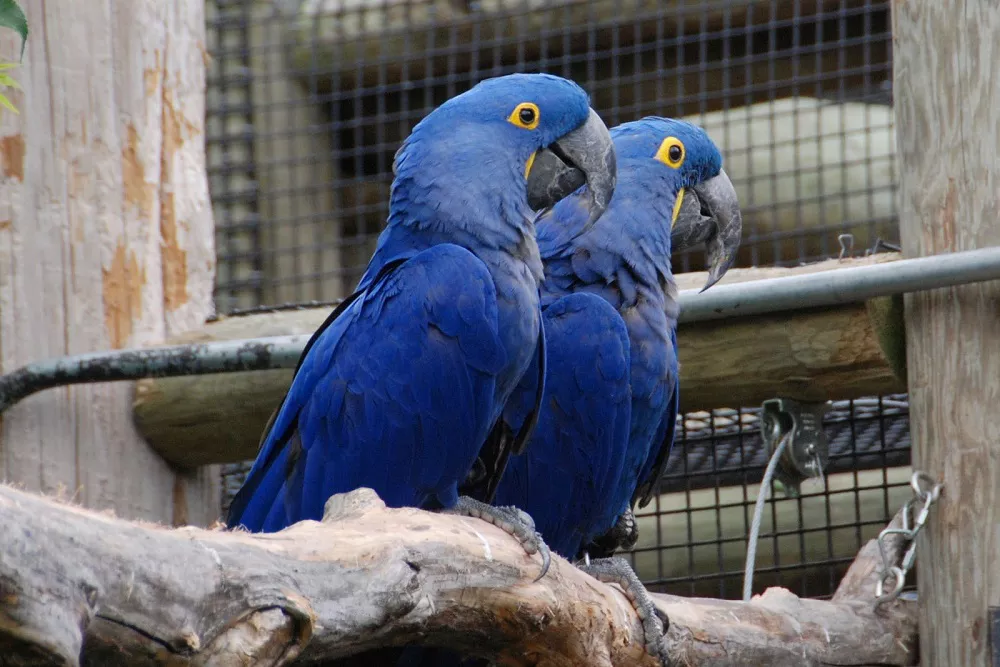The Hyacinth Macaw (Anodorhynchus hyacinthinus) stands as a true marvel among the avian species, captivating hearts with its vibrant plumage and impressive size. As the largest of all parrots, this magnificent bird possesses both physical grandeur and a charismatic presence. In this article, we delve into the world of the Hyacinth Macaw, exploring its unique characteristics, habitat, behavior, and conservation status.
Appearance and Size:
The Hyacinth Macaw is renowned for its striking appearance, characterized by vibrant cobalt blue feathers, a distinctive yellow eye-ring, and a prominent black beak. With a wingspan of up to 4 feet (120 cm) and an average length of around 40 inches (100 cm), it is the largest flying parrot species in the world. This majestic size contributes to its awe-inspiring presence in its natural habitat.
Habitat and Distribution:
The natural range of the Hyacinth Macaw extends across central South America, encompassing Brazil, Bolivia, and Paraguay. These macaws are typically found in the expansive savannas, palm groves, and tropical forests of these regions. They exhibit a preference for areas near water sources, such as rivers and wetlands, which provide ample food resources and suitable nesting sites.
Behavior and Social Structure:
Hyacinth Macaws are highly social birds that form lifelong monogamous bonds with their partners. They are often seen in pairs or small family groups, engaging in various social activities, including preening, playing, and vocalizing. These birds possess a range of vocalizations, including squawks, screeches, and low-pitched “gronk” sounds, which are used for communication and territorial defense.
Feeding Habits:
The diet of the Hyacinth Macaw is primarily composed of palm nuts, particularly from the acuri and bocaiuva palm trees. With their powerful beaks, they can easily crack open the hard shells to access the nutritious kernels inside. Additionally, they consume a variety of fruits, seeds, and occasionally vegetation, complementing their diet with calcium-rich mineral licks found in riverbanks or exposed cliffs.
Breeding and Reproduction:
Hyacinth Macaws reach sexual maturity around the age of 7-10 years. They construct their nests in tree cavities, usually within large, established trees. The female typically lays two eggs, with an incubation period of around 28-30 days. Both parents participate in incubation and later in the care and feeding of the hatchlings. The chicks fledge after approximately 100 days, but they remain dependent on their parents for several more months.
Threats to their Existence:
The Hyacinth Macaw is listed as endangered by the International Union for Conservation of Nature (IUCN), with estimates suggesting there may be fewer than 6,500 individuals left in the wild. The primary threat to their existence is habitat loss, as their natural habitat continues to be destroyed at an alarming rate due to human activities such as logging, agriculture, and mining.
Illegal poaching for the pet trade is another significant threat to Hyacinth Macaws. These birds are highly sought after by private collectors and breeders, leading to a thriving black market for their capture and sale. Poaching not only negatively impacts the bird’s population but also disrupts family structures and can lead to physical harm or death during capture.
Conservation Efforts:
Several conservation efforts have been put in place to protect the Hyacinth Macaw and its habitat. In Brazil, where the largest population of the species resides, the government has created protected areas and implemented strict laws against poaching and illegal trade of the birds. Argentina, Bolivia, and Paraguay have also established conservation programs aimed at protecting the species and preserving their habitat.
In addition to government-led initiatives, several non-profit organizations, such as the Hyacinth Macaw Project and the World Parrot Trust, work tirelessly to protect these birds and educate the public about their importance.
Conclusion:
The Hyacinth Macaw stands as a symbol of grace and beauty in the avian world. With its majestic size, striking plumage, and captivating presence, this remarkable parrot species has captured the imagination of bird enthusiasts and conservationists alike. Efforts to protect their natural habitats, combat illegal trade, and raise awareness about their conservation needs are crucial to ensure the continued survival of this awe-inspiring bird and preserve its rightful place as one of nature’s most extraordinary creations.


 Facebook
Facebook  Instagram
Instagram  Youtube
Youtube 